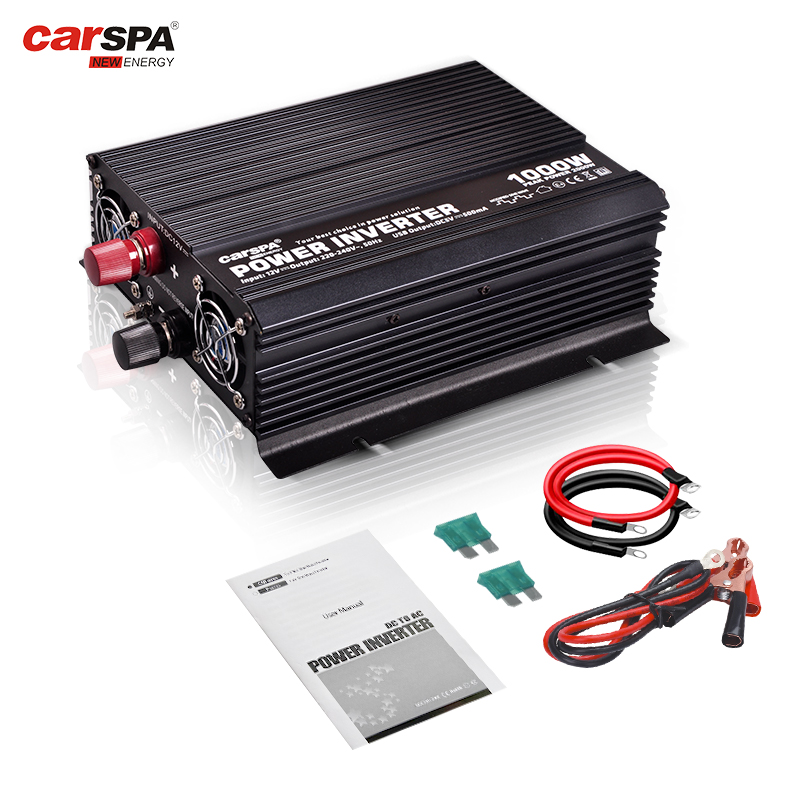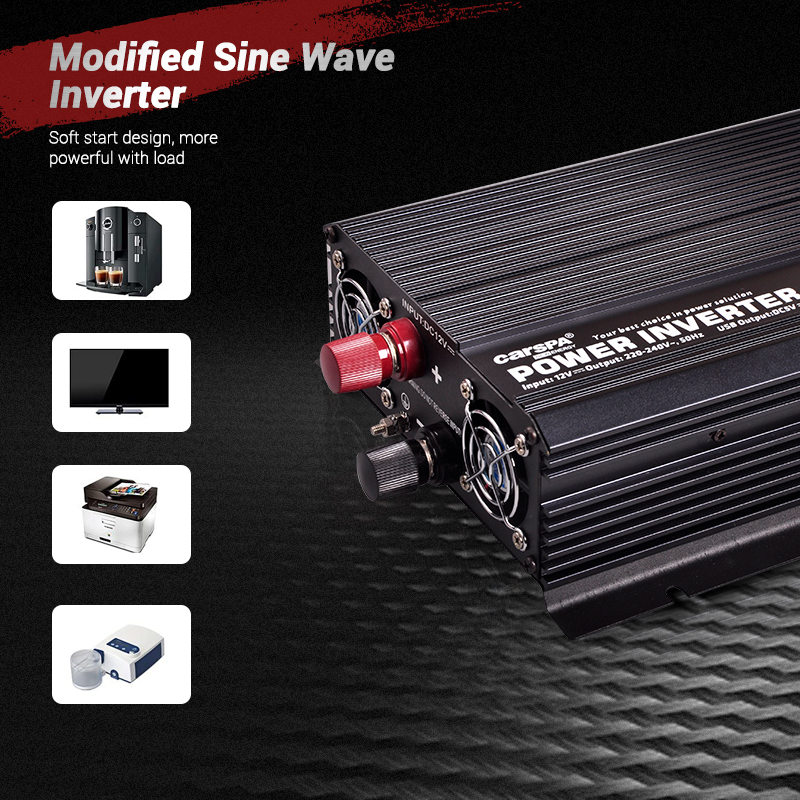How Many Batteries You Really Need for 1000W Inverter?
In daily life or outdoor activities, the use of inverters is very common, especially inverters with a power range like 1000W, which can provide stable power support for common electrical equipment. However, many users face the same problem when using inverters: how many batteries are needed to support a 1000W inverter? The answer to this question depends not only on the power of the device itself, but also on multiple factors such as battery capacity, usage time, load conditions, and system voltage.
What is the power requirement of a 1000W inverter?
Power definition and practical application of inverters
A 1000W inverter, as the name suggests, is a device that can provide a power output of 1000 watts, which means it can provide power for devices of the same or less than 1000W. For example, in emergency situations such as RVs, camping, or power outages, a 1000W inverter can drive lamps, fans, TVs, and even some small power tools. However, it is important to note that the power of the inverter indicates the maximum power it can provide, while the actual power depends on the connected load device.
If you are powering a device with a power of 500W, then even if the maximum power of the inverter is 1000W, the actual power consumption is only 500W. Therefore, when calculating the battery requirements, the actual power consumption of the device should be calculated, not the maximum power of the inverter.
Calculating current requirements
When using a 12V battery to power the inverter, you need to know the current required by the inverter when it is running. This can be calculated using the formula:
Current (A) = Power (W) ÷ Voltage (V)
If the output power of the inverter is 1000W and the battery voltage is 12V, the current requirement is:
1000W ÷ 12V = 83.33A
This means that a 1000W inverter will require about 83.33 amps of current per hour when running at full capacity. If you plan to use a higher voltage battery system (such as 24V or 48V), the current requirement will be greatly reduced. For example, when using a 24V battery, the current requirement is:
1000W÷24V=41.67A
When using a 48V battery, the current requirement is:
1000W÷48V=20.83A
The higher the battery voltage, the lower the current required, which not only reduces the pressure on the battery but also extends the battery life.
How many batteries do I need to support the continuous operation of a 1000W inverter?
Calculate the battery capacity requirements
Battery capacity is usually measured in ampere hours (Ah), which indicates how long the battery can continuously supply power at a specific current. Assuming you want a 1000W power inverter to run at full load for 1 hour, and you are using a 12V battery, the required battery capacity is calculated as follows:
Battery capacity (Ah) = current (A) × time (hours)
Based on the previous current calculation results, the battery capacity requirement is:
Battery capacity = 83.33A × 1 hour = 83.33Ah
This means that in order to support a 1000W inverter to run at full load for 1 hour, at least one 12V 100Ah battery is required. As the running time increases, the battery capacity requirement also increases accordingly. For example, if you want to run for 2 hours, the required battery capacity is:
Battery capacity = 83.33A × 2 hours = 166.66Ah
Parallel and series battery configuration
To meet different voltage or capacity requirements, the system can be configured by connecting multiple batteries in parallel or in series. The total capacity of the battery can be increased by connecting batteries in parallel, while the voltage of the system can be increased by connecting batteries in series.
Parallel batteries: If you need to increase the battery capacity, you can connect multiple 12V 100Ah batteries in parallel so that the voltage remains the same, but the capacity is added. For example, after connecting two 12V 100Ah batteries in parallel, the system is still 12V, but the total capacity is 200Ah, which can support the inverter to run for a longer time.
Series batteries: If you need to increase the voltage, for example, if you want to use a 24V battery system, you can connect two 12V 100Ah batteries in series to form a 24V 100Ah system, and the current demand is reduced by half, but the capacity remains the same.
The impact of usage time on the number of batteries
If you want the inverter to run continuously for a long time, the number of batteries required will increase significantly. Assuming that you want the inverter to run continuously for 4 hours, then for a 12V system, the battery capacity requirement is:
Battery capacity = 83.33A × 4 hours = 333.32Ah
This means that you need at least 4 12V 100Ah batteries to meet the 4-hour running time. Similarly, for 24V or 48V systems, as the voltage increases, the battery demand will decrease accordingly, but the total capacity needs to remain consistent.
The impact of different types of battery selection on inverter operation
The common battery types on the market are lead-acid batteries and lithium batteries, both of which have their own advantages and disadvantages. Choosing the right battery type is an important step to ensure the long-term and stable operation of the inverter.
Advantages and disadvantages of lead-acid batteries
Advantages: Lead-acid battery technology is mature and relatively low in price, making it the first choice for many homes and small systems. Deep-cycle lead-acid batteries can be charged and discharged many times and are suitable for backup power supplies and solar energy systems.
Disadvantages: Lead-acid batteries are heavy, large in size, and have low charge and discharge efficiency (usually 50% to 60%). They cannot withstand deep discharge, so they can usually only use half of their nominal capacity. For example, if the calculation requires a battery capacity of 100Ah, a 200Ah lead-acid battery is actually required to ensure that the battery will not be damaged due to excessive discharge.
Advantages and disadvantages of lithium batteries
Advantages: Lithium batteries have high energy density, small size, light weight, and can support deep discharge, with a charge and discharge efficiency of more than 80%. Lithium batteries also have a longer service life and are suitable for scenarios that require frequent charging and discharging or high mobility requirements.
Disadvantages: The initial investment cost of lithium batteries is high, but in the long run, the high efficiency and life of lithium batteries are more suitable for long-term use, especially for equipment that needs to run at high power for a long time.
Optimize battery configuration according to actual needs
In actual applications, when configuring batteries for a 1000W car inverter, not only the capacity and type of the battery should be considered, but also the configuration should be optimized according to the specific usage scenario.
Short-term use vs long-term use
If you only use the inverter for a short period of time, such as temporary outdoor activities or emergency power supply, the battery capacity does not need to be too large, and 1 to 2 12V 100Ah batteries can usually meet the needs. For long-term use scenarios, such as RVs, outdoor camping or home solar power supply systems, it is recommended to configure more batteries and combine with solar energy systems to ensure continuous power supply.
Use with solar energy systems
Using an inverter in combination with solar panels can significantly reduce the discharge frequency of the battery, thereby extending the battery life. Through a solar charge controller (such as an MPPT controller), the efficiency of solar power generation can be optimized, and the battery can be charged using sunlight during the day, reducing the pressure on the battery at night. This configuration is very practical in RVs and outdoor camping, and can achieve long-term independent power supply without the power grid.
Importance of backup power
In some scenarios (such as power outage emergency or outdoor work), it is very important to ensure sufficient backup power. It is recommended to increase the capacity by 20% to 30% based on the theoretical battery demand to cope with unforeseen situations. For example, if the calculation shows that a 200Ah battery is required, you can consider configuring a 250Ah to 300Ah battery pack to ensure normal power supply when the unexpected load increases or the power supply is unstable.
Conclusion
When configuring batteries for a 1000-watt power inverter, you must consider a variety of factors, including battery capacity, load conditions, usage time, system voltage, and battery type. By reasonably calculating battery requirements, selecting the appropriate battery type (such as lead-acid batteries or lithium batteries), and optimizing the configuration according to the actual usage scenario, you can ensure that the inverter can operate stably for a long time.
Whether it is a short-term power supply demand or a long-term outdoor scenario, understanding the discharge principle of the battery, reasonably distributing the load, and combining it with auxiliary energy such as solar energy are the keys to ensuring the efficient operation of the system. Regularly maintaining your battery and avoiding deep discharge and overcharging will also help extend the life of your battery.







